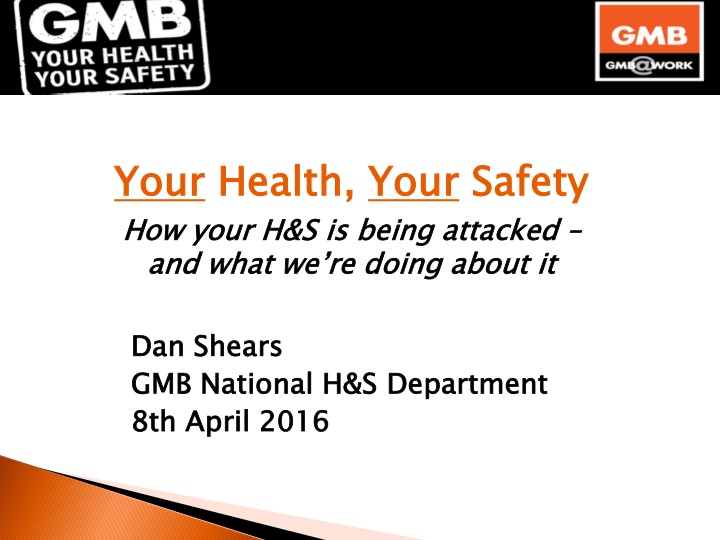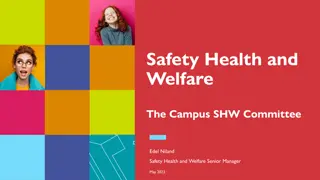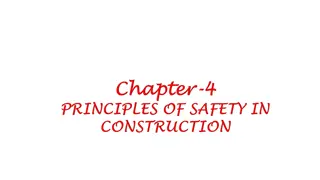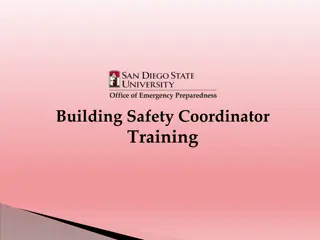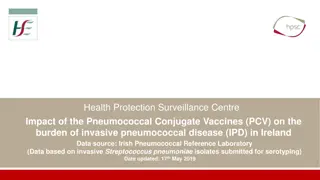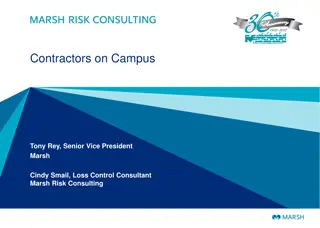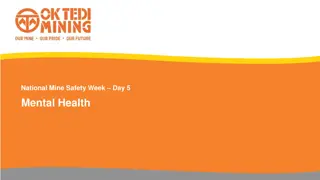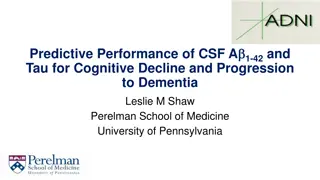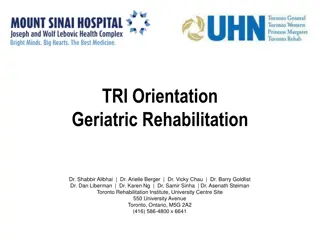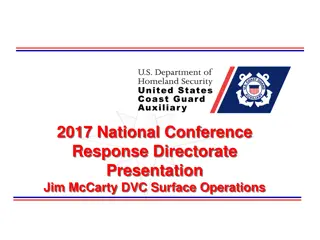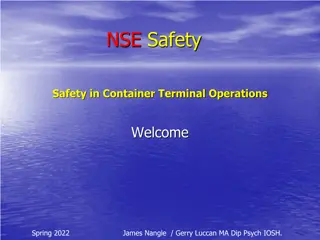Challenging Health and Safety Decline
Successive governments in Great Britain have undermined health and safety standards. Learn about the impact of policy changes and how to fight back against declining safety measures to renew society's commitment to safe working conditions.
Download Presentation

Please find below an Image/Link to download the presentation.
The content on the website is provided AS IS for your information and personal use only. It may not be sold, licensed, or shared on other websites without obtaining consent from the author.If you encounter any issues during the download, it is possible that the publisher has removed the file from their server.
You are allowed to download the files provided on this website for personal or commercial use, subject to the condition that they are used lawfully. All files are the property of their respective owners.
The content on the website is provided AS IS for your information and personal use only. It may not be sold, licensed, or shared on other websites without obtaining consent from the author.
E N D
Presentation Transcript
Your How and Your Health How your and what Health, , Your your H&S what we re Your Safety being attacked we re doing Safety attacked doing about H&S is is being about it it Dan Shears GMB National H&S 8th April 2016 Dan Shears GMB National H&S Department 8th April 2016 Department
Political Background Coalition Government Conservative Policies Coalition Government Conservative Policies Impact of Policy Changes How we fight back The 6 myths that must be challenged GMB Special Report What you can do The 6 myths that must be challenged GMB Special Report Your Health, Your Safety What you can do Your Health, Your Safety
This is a tale of successive governments both the Coalition and the Tories have downplayed, under-resourced and undermined health and safety standards in Great Britain The key issue is not whether we accept this agenda it has already been imposed upon us Our challenge is to reverse this decline and renew society s commitment to safe and healthy work
2010 Lord Young Common Sense, Common - RIDDOR changes; low hazard workplaces Common Sense, Common Safety Safety 2010 Comprehensive Spending Review HSE budget over 3 years Comprehensive Spending Review - 35% cuts to 2011 Grayling s Good Health and Safety: Good for everyone inspections cut by 33% -11,000 cut in HSE inspections, 65,000+ in Local Authorities Good Health and Safety: Good for everyone HSE fee for intervention ; proactive 2012 Lofstedt Review employee blame, with a view to removing burdens from business Lofstedt Review of all H&S law, EU law, and
Following Graylings new strategy preventative inspections are still allowed in Nuclear & Major Hazard industries, and in: Construction Foundries Waste/ recycling Glass But not not in equally high risk: agriculture, quarries, docks, social care, manufacturing, electrical engineering, transport Post Office, NHS, schools, offices, shops, whole of public sector etc. - now reclassified low risk
I have concluded that in general there is no case for radically altering current health and safety legislation. The regulations place responsibilities on those who create the risk, recognising that they are best placed to decide who to control them and allowing them to do so in a proportionate manner. There is a view across the board that the existing regulatory requirements are broadly right and that regulation has a role to play in preventing injury and ill-health in the workplace. Indeed there is evidence to suggest that proportionate risk management can make good business sense.
Red Tape Challenge No new burdens for 3 years on employers of 10 or less No new regs except from EU and no gold plating One in, one out , and Sunsetting clauses Sickness Absence Review and Fit Notes Attacks on legal aid, access to justice TU Bill - Attacks on facility time in public sector
The Rump HSE: Completely reactive in most Sectors Focused on high societal hazard Fewer Inspectors in fewer Regional Offices Further sectoral risk classification More workers out of scope agency workers, ZHCs, self-employed Further loss of policymaking expertise
Nothing the previous or current Government has done work death Nothing the previous or current Government has done will prevent a single work- -related injury or death will prevent a single related injury or
1. Modern work doesnt cause much harm 2. H&S is over the top, gone mad 3. Most workplaces are low hazard/risk 4. Compensation Culture is rife 5. H&S laws and enforcement are a burden on business 6. H&S is only common sense so no need for law and enforcement
Myth/Lie No.1: Health and Safety in Britain is one of best in world and very few people now hurt by modern work. THE TRUTH: Up to 1,500 killed in work-related incidents Up to 50,000 die due to work-related illnesses Millions made ill by work EVERY YEAR; Britain only 30 out of 176 countries for occupational safety and health performance in Maplecroft Risk Index report 2010, 20thout of 34 OECD countries; We have more occupational ill-health now than ever, according to occupational health experts.
Myth/Lie No. 2. Health and safety has gone mad, its over the top, over enforced, over bureaucratic. TRUTH: Average business spends 20 hours & 350 a year on risk assessment Less spot inspection of workplaces literally once in a lifetime 98% collapse in LA inspections Less investigations: only 1 in 9 major and fatal injuries even investigated Less enforcement action, fewer prosecutions: down 50% over 10 years and in 98% of major injuries there is no enforcement action taken against the employer at 98% of major injuries there is no enforcement action taken against the employer at all all
Myth/Lie No.3: Offices, shops, schools are non- hazardous . TRUTH: You re less likely to be killed or physically injured, but workers face: Musculoskeletal risks from working with computers; Violence from customers and pupils; A whole host of stress-related illnesses caused by bullying and harassment, by long hours and excessive workloads; Physical risks from buildings, electricity, asbestos. Undermines HSWA 1974 applying equally to all workers. but these
Myth/Lie No. 4. Compensation culture is rife TRUTH: Less than 10% of workers made ill, injured and the families of those killed by work, get any sort of compensation at all Reports show ECLI, Public Liability and Medical Negligence claims going down -only road traffic incident claims up
Myth/Lie No.5: H&S only common sense, no need for laws and enforcement, firms will do right thing TRUTH: Workers are made ill and killed every day due to employers failing to manage health and safety All the evidence shows what works is clear laws, strictly enforced to protect workers from ignorant, non-compliant and often criminally negligent employers Voluntary schemes and trust the boss don t work!
Myth/Lie No 6: Health and safety costs too much TRUTH: Good health and safety saves lives and employers and the state money; British Chambers of Commerce estimate cost of H&S compliance at 375M per year fail to deduct savings, e.g. lower insurance premiums, less compensation, less fines, less sickness, lost production or service time. Nor do they add in the cost of poor health and safety to society This is estimated at 14-20BN plus all the cost of long latency occupational illnesses 40 billion EVERY YEAR and who pays YOU DO we/state pay via health and benefit costs but the employers who cause the damage pay less than 25%! plus all the cost of long latency who pays? occupational illnesses, like cancers @ 2.43 million each = well over YOU DO workers and their families pay in heartbreak and poverty, cause the damage pay less than 25%! the employers who
Wrong to label certain sectors as low-risk: Schools Stress, asbestos and violence Shops Slips and trips, manual handling, violence (GMB SafeGuard campaign) Offices Stress, MSDs/WRULDs Just because there aren t large numbers of deaths in these sectors, doesn t mean there aren t serious health and safety issues Changes to RIDDOR will only take thousands of injuries off the records, and fiddle the statistics Reducing risk assessment will do nothing to help, and will create a two-tier health and safety system
Health and safety needs to be a far higher union priority at this time as we have not cracked it ; it has not gone off the radar , and the current political changes are not being sufficiently challenged Indeed, much of what is happening is occurring with little scrutiny, and much right wing applause We have to act now to stop further damage being inflicted through the back door We have to act now to stop further damage being inflicted through the back door
World of work has changed: Zero Hours; agency working precarious work Workplace hazards/risks are changing move to services from manufacturing economy; contracting out in public sector Regulatory framework has been weakened: Less regulation Less enforcement Less compensation Special Report gives way forward
Dedicated RHSO in every GMB Region Ensure that Regional Health, Safety and Environment forums are organised and take place at least twice per year, directly reporting to Regional Committees Create a National Health, Safety and Environment forum, populated by delegates elected from Regional Health, Safety and Environment forums, and with the ability to submit a resolution to GMB Congress Hold a National Health, Safety and Environment conference each year
Survey our members to find out what your issues and concerns are, and what extra support you need Link in to the wider equality agenda to help to recruit the next generation of GMB Health, Safety and Environment Representatives, with a particular focus on young members, BME members and women Better recognise the achievements of our Health and Safety Representatives beyond the annual Safety Representative of the Year award at GMB Congress
Looking at the opportunities around Health, Safety and Environment as part of the ongoing GMB Branches Review Looking at simplifying access to training beyond that offered by GMB and the TUC to address specific hazards, issues or concerns. Seek to appoint more lay Health and Safety Representatives to HSE Industry Advisory Committees (IACs) and sectorial forums
Refresh and update the GMB Health and Safety Representatives Handbook as part of the GMB Workplace Organisers Toolkit Ensure that all new GMB representatives complete basic Health and Safety training as part of their induction programme Make the GMB Inspection Report Form available to complete online using tablets and smartphones. Develop simple one page quick guides on key health, safety and environment topics
Publish new guidance and case studies on organising in the workplace using health, safety and environment issues. Use new technology and new avenues, such as Twitter, GMB TV on YouTube, and podcasts to communicate developments and campaigning activity. Ensure that the GMB Website on Health, Safety and the Environment is regularly updated and has the most up-to-date information possible. Publish a GMB Health, Safety and Environment newsletter every month.
Deliver a campaign to reassert Health and Safety Representatives Rights and reinvigorate inspection activity. Develop new campaigns and guidance on emerging issues such as mental health, bullying & harassment, nanotechnology and occupational health, particularly around the aging workforce.
Encourage and train GMB Health and Safety Representatives to make use of regional and national media communication channels Co-ordinate GMB activity around International Workers Memorial Day Regularly lobby parliament to ensure that health, safety and environment issues retain a high profile and remain in the public eye.
Use the real figures and give a clear picture Workplace meetings Branch meetings GMB Congress motions TUC, Labour Party and beyond
Largest ever GMB Survey 364,000 printed We need your feedback what you want and how you want it Online at: www.surveymonkey.co.uk/r/GMB_H_S_E_Survey_2016
Two pronged approach: 1. Defend members health and safety in your workplaces 2. Campaign inside and outside workplace and union against the cuts Use Workers Memorial Day and evidence from GMB, TUC, Hazards Campaign and magazine to challenge the lies, act locally and build up a massive grassroots movement into a national campaign against the biggest threat to our health and safety for years.
Unions make work safer & healthier - half as many incidents & illness in organised workplace with safety rep- use it to recruit and retain members Revitalise union organisation in workplaces, use all rights as safety rep to protect members H&S to be consulted, given information, to do quarterly inspections, to investigate incidents and ill-health, involvement in Risk Assessments, to monitor injury and ill-health stats Build case for reactive inspection/intervention by Inspectors when you have exhausted all internal procedures, make complaints about breaches of law with care: Email HSE - turepconcerns@hse.gsi.gov.uk
National Level: Lobbies of Parliament Briefing MPs, Councillors etc Advice / Roadshows to Regions Use Workers Memorial Day to raise profile Make sure we use the real figures 20,000 deaths, not 150
Workplace Level Re-enforce your role: Inspections, Investigations, Advice, Holding the employer accountable through the workplace H&S Committee Recruit, organise and defend your rights, before they are lost
For more info: E: daniel.shears@gmb.org.uk E: lynsey.mann@gmb.org.uk T: @SaferWithGMB Any Questions?
